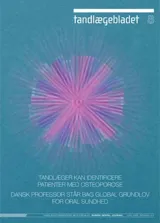Canalis incisivus: En oversigt med særligt henblik på implantatbehandling regio 1+1
Canalis incisivus er en struktur, som viser stor variation mht. til dimension og forløb, og som i visse tilfælde kan kompromittere eller umuliggøre implantatindsættelse i regio 1+1. Ved planlægning af implantatbehandling i regionen er en kortlægning af kanalens anatomi og relation til omgivende strukturer nødvendig. Kanalen er utilgængelig for klinisk vurdering, og dens anatomi kan udelukkende belyses ved billeddiagnostisk undersøgelse. I tilfælde af at kanalens lokalisation og udstrækning hindrer eller vanskeliggør implantatindsættelse, er der afprøvet teknikker med obliteration af kanalen med autogen knogle eller knoglesubstitutter samt med immediat implantatindsættelse i kanalen, men de må betegnes som forsøgsvise. I artiklen redegøres for forhold vedr. canalis incisivus og implantatindsættelse i regio 1+1.
The incisive canal. A survey with particular reference to implant surgery: The incisive canal is an anatomical structure, which like the maxillary sinus and inferior alveolar nerve may complicate or even make implant insertion impossible. The anatomy of the canal is reviewed, as well as anatomical variations (persisting nasopalatine duct) and pathology (naso palatine cyst formation). Methods of obliterating the canal with autogenous bone or bone substitutes and subsequent implant insertion, and prepara tion of the canal and immediate insertion have been tested, but evidence of succes is limited and control periods are short. In planning dental implant treatment in the incisor re gion knowledge of the incisive canal anatomy is essential. Intraoral ra diography provides excellent details, but only in two dimensions. For three dimensional imaging tomographic or 3D techniques are necessary


